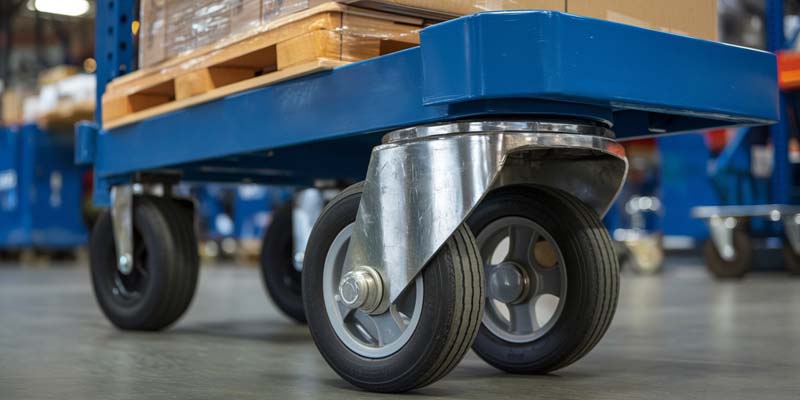Heavy vs. Medium vs. Light-Duty Casters: How to Make the Right Choice
Sep 30th 2024
Choosing the right caster for your equipment isn't just a matter of convenience- it's crucial for safety, efficiency, and protecting your valuable assets. Casters are small wheels that support and move heavy objects, but picking the wrong type can lead to various issues. Imagine struggling to push a heavy cart across a rough surface or watching equipment wobble dangerously because the casters aren't suited for the load. This can result in frustrating work conditions, potential equipment damage, and even safety hazards.
Whether it's light-duty casters for office chairs, medium-duty for carts and racks, or heavy-duty options for industrial machinery, selecting the right caster ensures smooth movement, reduces the risk of tipping, and minimizes wear and tear on floors and equipment. Have you ever struggled with moving heavy equipment or furniture? The proper caster makes all the difference! This guide provides the differences between heavy, medium, and light-duty casters, ensuring you make the best choice for your needs.
Going back to the Basics: Types of Casters

Casters are wheel assemblies designed to make it easier to move heavy objects. They are commonly used on carts, furniture, industrial equipment, and other items that need mobility. Caster wheels come in various types, each affecting how easily an object can be maneuvered.
A popular type of casters is the swivel casters, which rotate 360 degrees, allowing smooth movement in any direction. They are ideal for applications that require high maneuverability, such as office chairs or carts that need to navigate tight spaces.
Fixed or rigid casters move only in a straight line, offering stability and straightforward control. They are often used alongside swivel casters on items that need to travel longer distances in a straight path, like heavy machinery or storage racks.
Specialty casters include options like locking casters, which provide added safety, or pneumatic casters that offer a cushioned ride over rough surfaces. These are tailored for specific environments and needs, such as medical equipment or outdoor applications.
Choosing the correct caster depends on the intended use, load capacity, and surface conditions. Knowing the different types of casters—swivel, rigid, and specialty—can help select the best option for optimal performance and maneuverability in various applications.
Light-Duty Casters: When Less Is More

Light-duty casters are designed for applications that require mobility without handling heavy loads. Typically made from plastic, rubber, or lightweight metal, they are built to support lower weight capacities, usually up to 250 pounds per caster. They are commonly found on items like office chairs, small furniture, light carts, and display stands.
Applications of Light-Duty Casters
These casters excel in environments where ease of movement is essential, but the weight requirements are minimal. For instance, office chairs often use light-duty casters to provide smooth, quiet mobility on hard floors or low-pile carpets. Similarly, small furniture pieces and light carts benefit from these casters, making them easily repositionable without much effort.
Pros and Cons
The following are the advantages and drawbacks of casters light duty:
Pros
- Easy to Move: Light-duty casters provide excellent maneuverability, making it easy to move objects with minimal effort.
- Affordable: These budget-friendly casters make them an economical choice for light applications.
- Widely Available: Light-duty casters are available in various sizes and styles to suit different needs.
Cons
- Limited Weight Capacity: These casters are not designed for heavy loads, limiting their use to lighter objects.
- Not Suitable for Rough Surfaces: Light-duty casters perform best on smooth, even surfaces and may need help on rough or uneven terrain.
Medium-Duty Casters: The Versatile Choice

Medium-duty casters perfectly balance light and heavy-duty options, offering better strength and durability without compromising maneuverability. Typically constructed from steel, high-quality rubber, polyurethane, or nylon, these casters can handle loads ranging from 250 to 1,000 pounds per caster, depending on the specific design and material. Their robust build makes them reliable for various applications where light-duty casters would fall short, but heavy-duty options might be overkill.
Applications of Medium-Duty Casters
Medium-duty casters are ideal for commercial and light industrial settings. They are commonly used on equipment such as commercial kitchen appliances, retail displays, and carts that need to be mobile yet sturdy. Light industrial environments also benefit from these casters, where mobility and moderate load-bearing capabilities are essential for efficiency and safety.
Pros and Cons
Here’s what causes the advantages and disadvantages of medium-duty casters:
Pros
- Balance Between Strength and Maneuverability: These casters offer a great mix of load capacity and ease of movement, making them suitable for diverse applications.
- More Robust Than Light-Duty Options: Built to withstand heavier use, medium-duty casters are more durable and resistant to wear and tear.
Cons
- May Not Handle Very Heavy Loads: While stronger than light-duty casters, they are not designed for cumbersome items, limiting their use in some industrial scenarios.
- Limited Options for Extreme Environments: Medium-duty casters may not perform well in extreme conditions, such as high heat or exposure to harsh chemicals.
Industries Using Medium-Duty Casters
Medium-duty casters are popular in the food service industry, retail, light manufacturing, and healthcare. Their versatility makes them suitable for tasks that require both mobility and a moderate level of load support.
Are you looking for a versatile caster that can handle a bit of everything? Medium-duty casters might be your perfect fit!
Heavy-Duty Casters: Built to Take on the Toughest Jobs

Heavy-duty casters are designed for applications that demand maximum strength, durability, and load-bearing capacity. Defined by their robust construction, these casters are typically made from high-strength materials like steel, cast iron, or reinforced polyurethane. They are engineered to support significant weight, often ranging from 1,000 to over 5,000 pounds per caster, making them ideal for the most demanding environments. Heavy-duty casters have larger wheels, reinforced frames, and industrial-grade bearings to ensure smooth operation under extreme conditions.
Applications of Heavy-Duty Casters
These casters are commonly used in industrial settings, including warehouses, factories, and environments that involve heavy machinery or equipment. Whether moving large manufacturing units, transporting heavy pallets, or supporting industrial carts, heavy-duty casters offer the strength and stability required to keep operations running smoothly. Specific examples include casters with load capacities like heavy-duty casters rated for 3,000 or even 4,000 lbs, showcasing their ability to handle substantial loads.
Pros and Cons
The following are some of the advantages and drawbacks of heavy-duty casters:
Pros
- Extremely Durable: Made from rugged materials, heavy-duty casters can withstand harsh environments, including rough surfaces and chemical exposure.
- Can Handle Rough Surfaces and High-Impact Loads: Their design allows them to navigate uneven floors, outdoor terrains, and areas with debris without compromising performance.
Cons
- Heavier and Often More Expensive: The materials and construction that provide their strength add weight and cost, making them a more significant investment.
- Requires More Effort to Move Manually: Due to their size and weight, heavy-duty casters can be more challenging to move by hand, often necessitating mechanical assistance for repositioning.
Need a caster that’s built to take on the most challenging jobs? Heavy-duty casters are your go-to solution for extreme durability and strength in demanding applications.
Critical Factors in Choosing the Right Caster
Selecting the right caster for your application ensures smooth operation, safety, and longevity. Considering key factors such as load capacity, surface type, material, and environmental conditions will help you take informed decisions that meets your needs.
Load Capacity and Weight Distribution
One of the most important considerations when choosing a caster is load capacity. Start by assessing the total weight of your equipment and how it is distributed across the casters. For example, if a cart weighs 1,000 pounds and uses four casters, each caster should have a load capacity of at least 250 pounds. However, it’s always wise to factor in additional safety margins, mainly if the weight is not evenly distributed. Misjudging weight distribution can lead to caster failure, so choosing casters that exceed your load requirements ensures reliability.
Surface Type
The type of surface your casters will navigate plays a significant role in your selection. Smooth floors like concrete or tile are best suited for hard wheels, such as steel or nylon, providing minimal rolling resistance. Rubber or polyurethane wheels are better suited for rough or uneven terrain, as they offer cushioning and better grip, reducing shock and protecting both the caster and the surface.
Material Considerations
The material of the caster wheel affects its durability, grip, and overall performance. Rubber wheels are quiet and provide good traction but may wear quickly under heavy loads. Polyurethane wheels offer a good balance of durability, noise reduction, and floor protection, making them versatile. Steel casters are heavy-duty, extremely robust, and ideal for high-impact applications, but they can be noisy and harsh on floors.
Environmental Factors
Environmental conditions such as heat, moisture, and exposure to chemicals can significantly impact the lifespan and performance of casters. For instance, rubber wheels can degrade in high temperatures or when exposed to certain chemicals. In contrast, stainless steel casters are resistant to corrosion and are suitable for wet or chemically harsh environments, such as food processing or medical facilities. Consider your working environment when selecting caster materials to ensure optimal performance and longevity.
Cost Analysis
Light-duty casters are the most affordable but may only last for a short time under frequent use. Medium-duty casters balance cost and durability, while heavy-duty casters represent a higher upfront investment with significant long-term value.
Are you weighing your options? Consider not just the load but also the environment and frequency of use.
Making the Final Decision: Questions to Ask Yourself

When choosing the right caster, asking the right questions is crucial. Start by considering the following questions:
- What will you be moving? Determine the weight and type of items to ensure you select casters with adequate load capacity.
- How often will you be moving it? Frequent use demands more durable, low-maintenance options.
- What kind of surface will the caster navigate? Smooth floors, rough terrain, or uneven surfaces require different materials and wheel types.
It is best to consult experts who gives valuable insights as per your needs and environment. Professional guidance can help avoid costly mistakes and select the right caster for optimal performance.
Still uncertain? Reach out for personalized advice on choosing the best caster for your needs. Taking the time to evaluate your requirements ensures you make a choice that ensures safety, efficiency, and ease of movement in your operations.
Wrapping up
Selecting the right caster is essential for ensuring safety, efficiency, and ease of movement in any setting. Choosing the appropriate caster type can significantly impact performance and longevity, Whether for light-duty office use, versatile medium-duty tasks, or heavy-duty industrial applications. Don't leave your decision to chance—knowing your needs and environment will help you make an informed choice.
Ready to move? Check out Atlanta Caster's range of casters to find the perfect match for your needs. Let us help you get undeterred mobility and efficiency in your workspace.




 Email US
Email US
 Hours
Hours
 Visit Our Showroom
Visit Our Showroom




